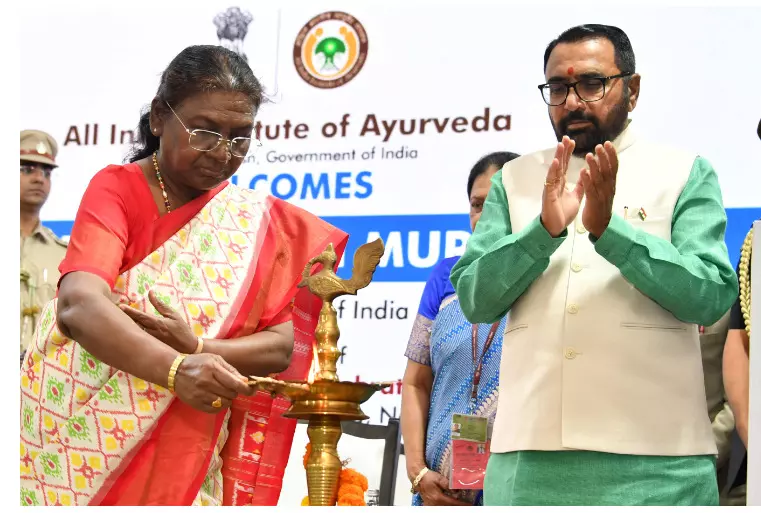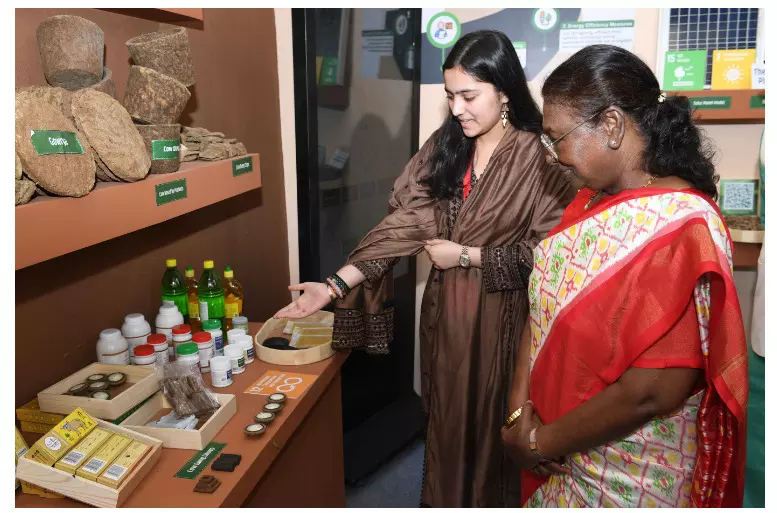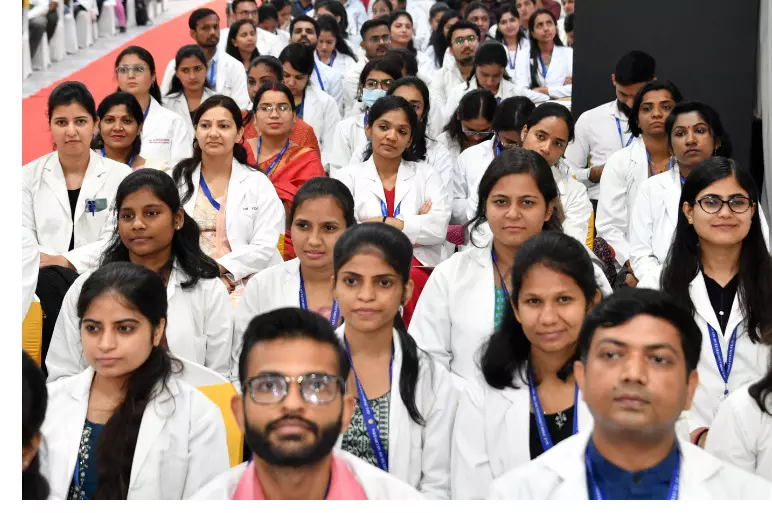Medical professionals should lead the fight against climate misinformation, say scientists
Powered by WPeMatico
Powered by WPeMatico
Powered by WPeMatico

Indianapolis: Eli Lilly and Company has announced the appointment of Thomas J. Fuchs, Dr.sc., as its first chief AI officer, effective Oct. 21, 2024.
In this role, Fuchs will provide vision, strategic direction and overall leadership of AI initiatives across Lilly, including drug discovery, clinical trials, manufacturing, commercial activities and internal functions. He will also identify, build and manage AI and machine learning solutions to help Lilly provide medicines to patients around the world.
Before joining Lilly, Fuchs was the dean and inaugural department chair for AI and Human Health at Mount Sinai, director of the Hasso Plattner Institute for Digital Health at Mount Sinai, and the endowed Barbara T. Murphy professor for AI and computational pathology at the Icahn School of Medicine at Mount Sinai. Prior, Fuchs held positions at Memorial Sloan Kettering Cancer Center, NASA’s Jet Propulsion Laboratory and the California Institute of Technology, and founded three companies, including Paige AI. Fuchs holds a doctoral degree in machine learning from ETH Zurich and a master’s in technical mathematics from Graz Technical University in Austria.
“In this new era of technology, the potential for artificial intelligence and machine learning to revolutionize health care is immense,” said Diogo Rau, Lilly executive vice president and chief information and digital officer. “Dr. Fuchs will contribute to Lilly’s breakthroughs in AI, aiding in the discovery and development of new medicines while enhancing patient outcomes. We are committed to leveraging these cutting-edge technologies to drive innovation and make a meaningful impact on lives around the world.”
“Lilly is at the forefront of health care innovation, and I’m tremendously excited to join this talented team at such a pivotal time in technological advancement,” said Fuchs. “Throughout my career, I have focused on leveraging technology to help patients and enhance human health. Joining Lilly will allow me to expand this mission worldwide on an amazing scale. Building AI to benefit millions of patients is profoundly humbling.”
Powered by WPeMatico

New Delhi: The President of India, Smt Droupadi Murmu graced the 8th foundation day of All India Institute of Ayurveda (AIIA) in New Delhi.
Speaking on the occasion, the President said that Ayurveda is one of the oldest medical systems in the world. It is India’s invaluable gift to the world. Ayurveda emphasizes holistic health management while maintaining a balance between mind, body and spirit.
The President said that we have always been aware of the medicinal value of the trees and plants around us and have been using them. In tribal society, the tradition of knowledge of herbs and medicinal plants has been even richer. But as society embraced modernity and moved away from nature, we stopped using that traditional knowledge. It became easier to get medicine from a doctor than adopt home remedies. Now awareness among people is increasing.
Also Read:All India Institute of Ayurveda inks MoU with Amity University to promote research, education
Today, the idea of an Integrative System of Medicine is becoming popular all over the world. Different medical systems are helping to provide health to people as complementary systems to each other.
The President said that we have unwavering faith in Ayurveda from generation to generation. Some people take advantage of this faith and cheat innocent people. They spread misleading information and make false claims, which not only harm the money and health of the public but also defame Ayurveda. She stated that more and more qualified doctors are needed so that people do not have to go to uneducated doctors.


She was happy to note that in the past few years, the number of Ayurveda colleges and students has increased significantly. She expressed confidence that in the coming times, the availability of qualified Ayurvedic doctors will increase further.
The President said that the development of Ayurveda will not only be beneficial for humans but also for animals and the environment. Many trees and plants are becoming extinct because we do not know about their utility. When we know their importance, we will preserve them.


The President said that people associated with different systems of medicine often claim that their system is the best. It is good to have healthy competition among themselves but there should be no attempt to criticize each other. There should be a sense of cooperation among people associated with different systems of medicine. The aim of all is to do good to humanity by curing the patients. We all pray ‘Sarve Santu Niramayah’ – everyone should be free from diseases.

The President said that we have to focus on research and continuous improvement in the quality of medicines to ensure the relevance of Ayurveda. We also need to empower the Ayurveda educational institutions. She was happy to note that the All India Institute of Ayurveda, combining traditional education with modern technology, has made its important place in Ayurvedic medicine, education, research and overall healthcare in a short span of time.
Powered by WPeMatico

A new study published in the journal of Diabetes Care found that pediatric obesity with metabolic dysfunction-associated steatotic liver disease (MASLD), as determined by transaminases or diagnostic code, is related to an elevated risk of developing type 2 diabetes at a young age.
In high-income nations, the prevalence of pediatric obesity has increased two- to three-fold over the past 30 years. The WHO Global Health Observatory’s 2017 data indicates that approximately 340 million children and adolescents between the ages of 5 and 19 are affected by obesity. The incidence of obesity is rising in tandem with other metabolic diseases such type 2 diabetes (T2DM), increased visceral obesity, dyslipidemia, liver steatosis, atherosclerosis, hypertension, and cholesterol cholelithiasis. Thus, this study was set out to evaluate the relationship between youth-onset type 2 diabetes and metabolic dysfunction-associated steatotic liver disease in pediatric obesity, the combined impact of MASLD and intermediate hyperglycemia on type 2 diabetes risk and the impact of obesity treatment on type 2 diabetes risk.
The Swedish Childhood Obesity Treatment Register (Barnobesitas Registret i Sverige [BORIS]) from 1999 to 2020 was used in a cohort study that was connected to national registers. A total of 10,346 overweight or obese youngsters and 59,336 matched control people were enrolled in the study. Transaminases and the diagnostic code were used independently to define MASLD. Data on type 2 diabetes was gathered from national databases.
The study found that the median follow-up age in the obese cohort were 8.1 (Q1, Q3: 5.1, 11.7) years, whereas the median age at type 2 diabetes diagnosis was 16.9 years. At age 30, the cumulative incidence of type 2 diabetes was 0.7% in control persons, 9.9% in obesity alone, and 22.7% in obesity plus MASLD.
The risk of type 2 diabetes was linked to MASLD, regardless of the influence of factors such as sex, age, obesity level, intermediate hyperglycemia, and a family history of the disease. The combined impact of intermediate hyperglycemia and MASLD elevated the probability of type 2 diabetes. Also, the treatment for obesity that produces an optimal response lowers the risk.
Overall, the outcomes of this study found that the individuals with MASLD had a shocking 2.71-fold higher risk of developing type 2 diabetes at a young age than their non-obese peers. When paired with intermediate hyperglycemia, the risk increased to 9.04 times that of MASLD. Fortunately, successful obesity therapy greatly reduced this risk, lowering the HR to 0.23.
Source:
Putri, R. R., Casswall, T., Danielsson, P., Marcus, C., & Hagman, E. (2024). Steatotic Liver Disease in Pediatric Obesity and Increased Risk for Youth-Onset Type 2 Diabetes. In Diabetes Care. American Diabetes Association. https://doi.org/10.2337/dc24-1236
Powered by WPeMatico

Austria: A recent randomized controlled trial, the EASE-TAVR study, has revealed promising insights into managing fluid overload (FO) in patients with severe aortic stenosis (AS). Conducted to assess the efficacy of quantitatively guided decongestive treatment, the study, published in JACC: Cardiovascular Interventions, highlights the advantages of a structured approach to post-transcatheter aortic valve replacement (TAVR) management.
The researchers revealed that in patients with severe AS and concurrent FO, a quantitatively guided decongestive treatment approach, combined with enhanced management following TAVR, led to better outcomes and improved quality of life than traditional management based solely on clinical judgment.
Fluid overload is a common and serious complication in patients with severe AS, often leading to increased morbidity and decreased quality of life. FO patients with severe AS face a heightened risk of heart failure and mortality following valve replacement, a risk that can be objectively assessed using bioimpedance spectroscopy (BIS). Considering this, Christian Nitsche, Department of Internal Medicine 2, Division of Cardiology, Medical University of Vienna, Vienna, Austria, and colleagues hypothesized that in patients with aortic stenosis and concurrent fluid overload, BIS-guided decongestion could enhance prognosis and quality of life after TAVR.
This randomized controlled trial involved 232 patients with severe aortic stenosis scheduled for TAVR. Following established criteria, fluid overload was evaluated using a portable whole-body BIS device (≥1.0 L and ≥7%). Among the patients identified with FO (n = 111), they were randomly assigned in a 1:1 ratio to receive either BIS-guided decongestion (n = 55) or decongestion based solely on clinical judgment (n = 56) after TAVR. The 121 patients without FO acted as a control group.
The primary outcome measured was a composite of hospitalization for heart failure and all-cause mortality within 12 months, while the secondary outcome focused on changes in the Kansas City Cardiomyopathy Questionnaire from baseline to 12 months.
The study led to the following findings:
“EASE-TAVR represents the first randomized controlled trial demonstrating that quantitatively guided decongestive treatment, along with intensified management, can enhance the quality of life and lower the risk of heart failure hospitalization and mortality in patients with severe aortic stenosis and concurrent fluid overload following valve replacement,” the researchers concluded.
Reference:
Halavina, K., Koschutnik, M., Donà, C., Autherith, M., Petric, F., Röckel, A., Spinka, G., Danesh, D., Puchinger, J., Wiesholzer, M., Mascherbauer, K., Heitzinger, G., Dannenberg, V., Koschatko, S., Jantsch, C., Winter, M., Goliasch, G., Kammerlander, A. A., Bartko, P. E., . . . Nitsche, C. (2024). Management of Fluid Overload in Patients With Severe Aortic Stenosis (EASE-TAVR): A Randomized Controlled Trial. JACC: Cardiovascular Interventions, 17(17), 2054-2066. https://doi.org/10.1016/j.jcin.2024.06.022
Powered by WPeMatico

USA: In a recent study published in JAMA Internal Medicine, researchers conducted the ARMS Crossover Randomized Clinical Trial, revealing significant discrepancies in blood pressure (BP) readings based on arm positioning.
The findings demonstrated that frequently adopted arm positions (resting on the lap or hanging by the side) significantly inflated blood pressure readings, potentially leading to misdiagnosis and an exaggerated assessment of hypertension.
Guidelines for BP measurement advise supporting the arm on a desk, with the midcuff aligned at the heart level. However, nonstandard positions—such as resting the arm on the lap or leaving it unsupported at the side—are still commonly utilized in clinical practice. In light of this, Hairong Liu, Department of Epidemiology, Johns Hopkins Bloomberg School of Public Health, Baltimore, Maryland, and colleagues aimed to assess the impact of various arm positions on blood pressure readings.
For this purpose, the researchers conducted a crossover randomized clinical trial in Baltimore, Maryland, enrolling adults aged 18 to 80 from August 9, 2022, to June 1, 2023. Participants were randomly assigned to undergo three sets of blood pressure measurements with their arms positioned in three ways: (1) supported on a desk (desk 1, reference), (2) hand resting on the lap (lap), and (3) unsupported at the side (side). To account for natural BP variability, each participant had a fourth set of measurements with the arm supported on a desk (desk 2).
The primary outcomes were the differences in mean systolic and diastolic blood pressure between the reference position (desk 1) and the other two positions (lap and side), calculated as (lap or side – desk 1) – (desk 2 – desk 1). Results were further analyzed based on hypertensive status, age, obesity, and healthcare access in the past year.
The following were the key findings of the study:
“The findings imply that frequently used, nonstandard arm positions during blood pressure measurements significantly inflate BP readings, underscoring the necessity for standardized positioning,” the researchers concluded.
Reference:
Liu H, Zhao D, Sabit A, et al. Arm Position and Blood Pressure Readings: The ARMS Crossover Randomized Clinical Trial. JAMA Intern Med. Published online October 07, 2024. doi:10.1001/jamainternmed.2024.5213
Powered by WPeMatico

A new study published in the recent edition of Journal of American Medical Association suggests that when providing enzyme-inducing antiseizure medications (EIASMs) to elderly patients who have epilepsy, doctors should use caution if there are additional cardiovascular risk factors present.
In their lifetime, one in 10 persons will experience at least one epileptic episode. Although epilepsy frequently strikes younger people, adults 60 years of age and beyond account for the majority of persons with epilepsy (PWE), both new onset and long-standing. There is a robust cross-sectional correlation between cardiovascular disease (CVD) and epilepsy. Also, a number of studies have demonstrated that there is a significant risk of developing cerebrovascular disease even in individuals whose epilepsy is not caused by it. Thereby, Jimmy Li and his team conducted this study to investigate the probabilities of new-onset cardiovascular events (CVEs) in patients with and without epilepsy during a 6-year period. Also, the mediation effects of EIASM usage and conventional cardiovascular risk factors (CVRFs) on this connection was investigated, with the goal of determining respective contribution of each factor to CVD risk in epilepsy.
This prospective cohort research utilized the whole cohort of the Canadian Longitudinal research on Ageing (CLSA) with a 6-year follow-up. The CLSA was a continuous, nationwide research project that recruited a total of 51,338 Canadian individuals between the ages of 45 and 85 at baseline. 30,097 people who reside close to one of the 11 data gathering centers make up the comprehensive cohort. A voluntary 45% of people took part in the CLSA. The people who had no prior history of CVEs at baseline were not included in the comprehensive cohort. There were no further exclusion standards used and 86% percent of participants finished the follow-up.
Of the 30,097 participants included in the comprehensive cohort, 27,230 had a history of epilepsy, 431 of whom were included in the total. Epilepsy patients had a 2.20 adjusted risk ratio for new-onset CVEs. Each of the following factors that mediated a different proportion of the effect of epilepsy on new-onset CVEs were;
Overall, the findings of this study found a correlation between epilepsy and newly diagnosed CVEs.
Source:
Li, J., Shlobin, N. A., Thijs, R. D., Sylvestre, M.-P., Josephson, C. B., Deacon, C., & Keezer, M. R. (2024). Antiseizure Medications and Cardiovascular Events in Older People With Epilepsy. In JAMA Neurology. American Medical Association (AMA). https://doi.org/10.1001/jamaneurol.2024.3210
Powered by WPeMatico

A recent research published in the Food Bioscience journal highlighted an critical connection between Type 2 taste receptors (T2Rs) and the regulation of appetite and blood glucose levels. While these receptors are traditionally associated with taste buds that perceive bitter flavors, they are also expressed in the gastrointestinal (GI) tract, where they play a significant role in homeostatic regulation.
The T2Rs of GI tract are activated by various ligands, including the bioactive compounds known as polyphenols, which are commonly found in plant-based foods. When these receptors are activated, they trigger the release of gastrointestinal hormones such as cholecystokinin (CCK) and incretin hormones like glucose-dependent insulinotropic polypeptide (GIP) and glucagon-like peptide-1 (GLP-1). These hormones have profound effects on appetite regulation, GI motility, and blood glucose homeostasis.
Cholecystokinin (CCK) and GLP-1 are peptides that play critical roles in managing food intake and appetite. CCK slows down gastric emptying, which prolongs the feeling of fullness after a meal, while GLP-1 improves insulin secretion in response to glucose, thereby helping in blood glucose control. Incretins like GLP-1 and GIP are particularly important as they stimulate insulin release by contributing to the maintenance of blood glucose levels within a healthy range.
One of the major insights from the research is the role of polyphenols, which are known for their strong bitter taste, are not well absorbed in the upper digestive tract. But, they travel through the digestive system to the colon, where they are excreted. However, during their journey through the GI tract, polyphenols interact with T2Rs, particularly in the GI tract, where they appear to trigger beneficial effects.
Epidemiological and intervention studies have consistently shown a negative correlation between polyphenol intake and the risk of developing diabetes. The proposed mechanism behind this protective effect involves the activation of T2Rs by polyphenols, which in turn leads to improved glucose tolerance and better regulation of appetite and intestinal motility.
The review suggests that the activation of T2Rs by polyphenols could be an important factor with their ability to modulate glucose metabolism and control appetite by offering a potential pathway for dietary interventions to prevent metabolic disorders like diabetes. Overall, the findings illuminate the importance of considering the bitter components of our diet, like polyphenols, not just for their nutritional value but also for their potential role in regulating key physiological processes.
Source:
Osakabe, N., Ohmoto, M., Shimizu, T., Iida, N., Fushimi, T., Fujii, Y., Abe, K., & Calabrese, V. (2024). Gastrointestinal hormone-mediated beneficial bioactivities of bitter polyphenols. In Food Bioscience (Vol. 61, p. 104550). Elsevier BV. https://doi.org/10.1016/j.fbio.2024.104550
Powered by WPeMatico

USA: A recent study in the American Journal of Ophthalmology has shed light on the risk factors associated with ocular complications in patients suffering from herpes zoster ophthalmicus (HZO) and the concerning rates of shingles vaccination within a large urban health system.
The researchers identified several key factors associated with the development of ocular complications in HZO, including age, female gender, use of steroids at the initial visit, and the presence of stromal keratitis. Additionally, they noted that shingles vaccination rates were low among the study population. The study stated that recognizing these risk factors and the low vaccination uptake can help pinpoint at-risk groups, ultimately aiding disease prevention efforts.
“The study involving urban patients with herpes zoster ophthalmicus found that corneal scarring was the most prevalent complication, occurring in 70% of cases,” the researchers reported.
Ann-Marie Lobo-Chan, University of Illinois at Chicago, Illinois Eye and Ear Infirmary, and colleagues aimed to analyze the epidemiology of herpes zoster (HZ) and HZO within an urban hospital system, focusing on identifying risk factors for ocular complications in HZO. They also sought to report the shingles vaccination rates and instances of HZ reactivation following vaccination in this population.
For this purpose, the research team conducted a retrospective cohort study involving patients treated at the University of Illinois Hospital system between January 1, 2010, and December 1, 2021, who were diagnosed with HZ and HZO based on diagnosis codes. They reviewed the medical records of HZO patients who had been seen within one year of their diagnosis. Using multivariable logistic regression analysis, they identified factors linked to the development of ocular complications in HZO.
Based on the study, the researchers reported the following findings:
As the authors highlight, the study emphasizes the interplay between demographic factors, clinical characteristics, and vaccination rates, calling for increased vigilance and action to protect at-risk populations from the debilitating effects of herpes zoster ophthalmicus. Enhanced awareness and vaccination initiatives, as suggested by the research, may be crucial in mitigating risks and improving overall health outcomes for this vulnerable group.
Reference:
Lobo-Chan, A., Song, A., Kadakia, A., & Mehta, S. D. (2024). Risk Factors for the Development of Ocular Complications in Herpes Zoster Ophthalmicus and Zoster Vaccine Utilization in a Large, Urban Health System. American Journal of Ophthalmology. https://doi.org/10.1016/j.ajo.2024.09.028
Powered by WPeMatico
